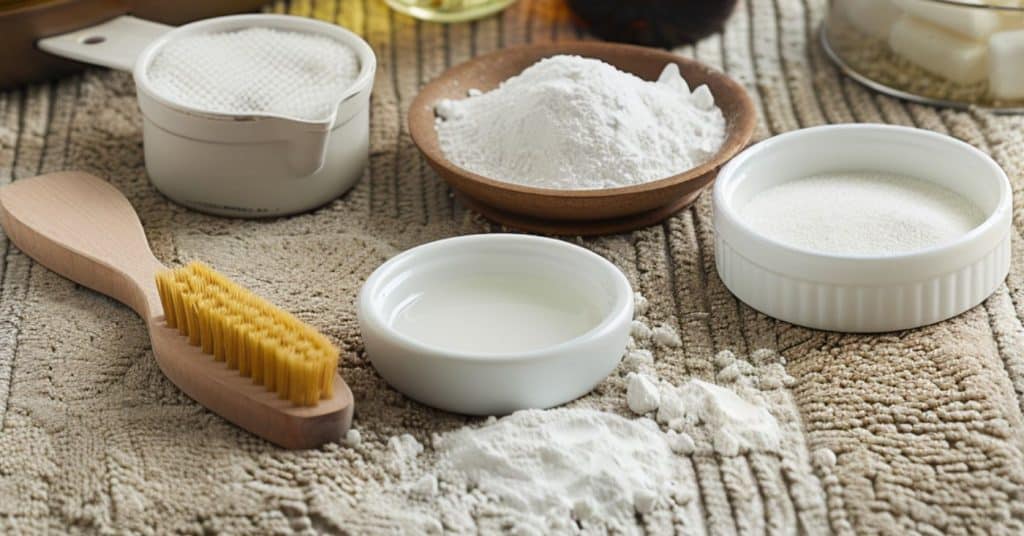In our quest for a pristine home, carpets often bear the brunt of daily life—collecting everything from dust to spills. The challenge of keeping them clean without resorting to harsh chemicals or expensive professional services is one we’ve all faced.
That’s where the magic of homemade carpet cleaning solutions comes in. Not only are they cost-effective, but they also offer a gentle yet powerful way to tackle stains and odors, ensuring our living spaces remain both inviting and safe.
We’ve delved into the world of DIY carpet care to bring you insights on the best homemade carpet cleaning solutions. These concoctions promise to revive your carpets, using ingredients you likely already have in your pantry.
Remember, if you don’t want to clean it yourself, you can always call us for our carpet cleaning services in Melbourne.
Understanding Homemade Solution For Carpet Cleaning
The Appeal of DIY Solutions
Homemade carpet cleaning solutions have quite the fan base. They combine convenience with effectiveness, wrapped up in the comfort of knowing you’re using ingredients right from your own pantry.
For those of us with a knack for tackling stains and odors without a trip to the store, the appeal is undeniable. It’s like having a magic potion at our fingertips, ready to revitalize our living spaces without the need for harsh chemicals or expensive gadgets.
Plus, the bragging rights that come with a spotless carpet, thanks to a concoction you whipped up next to the morning’s oatmeal, are not to be underestimated.
Safety and Eco-friendliness
In today’s world, the words “safe” and “eco-friendly” are not just buzzwords but benchmarks of quality home care. Homemade carpet cleaning solutions tick both of these boxes with an enthusiasm that’s hard to match. They allow us to minimize our households’ exposure to harsh chemicals, which is a win for everyone, especially families with little ones or pets scampering about.
Furthermore, by choosing ingredients that are biodegradable and commonly found in our kitchens, we contribute less to pollution and waste. It’s a small but significant step towards a healthier planet and home, proving that sometimes, the best solutions are indeed the simplest.
The Chemistry Behind Carpet Cleaning
Why the Right Ingredients Matter
Choosing the right ingredients for your homemade carpet cleaning solution is crucial. Let’s face it, not all stains are created equal, and neither are your home’s pantry supplies. Ingredients like baking soda, vinegar, and dish soap have proven time and again to be highly effective in breaking down dirt and eliminating odors.
But why? It’s all down to their chemical properties and how they interact with different types of stains. Baking soda, for example, is a wonder at absorbing odors, while vinegar’s acidity makes it great at cutting through grease.
So, combining the right ingredients can tackle just about anything your carpet throws at you, from coffee spills to muddy footprints.
The Role of pH in Cleaning Carpets
Understanding the pH scale is like unlocking a secret code to efficient carpet cleaning. The pH scale, which ranges from 0 to 14, measures how acidic or alkaline a substance is. Water, with a pH of 7, is neutral. Solutions with a pH less than 7 are acidic, while those with a pH greater than 7 are alkaline.
Why does this matter? Well, acidic solutions are ace at breaking down mineral deposits and rust, whereas alkaline solutions are your go-to for dissolving fats, oils, and other organic matter. By knowing the pH of your cleaning solution, you can choose the best approach to tackle specific stains.
For example, an acidic solution like vinegar works wonders on mineral stains, while an alkaline solution such as baking soda is brilliant for oily or greasy messes. And there you have it, a quick science lesson that’ll make your next carpet cleaning mission a breeze.
Top Homemade Carpet Cleaning Solutions
Baking Soda and Vinegar
Baking soda and vinegar come together to form a powerful duo for tackling carpet stains. This combination works wonders because the baking soda lifts stains from the fibers while the vinegar breaks them down. It’s like sending a mini cleanup crew right to the spot.
Hydrogen Peroxide and Dish Soap
A mix of hydrogen peroxide and dish soap acts as a super team for your carpet, especially for those pesky colored stains. Hydrogen peroxide lightly bleaches the stain, minus the harshness, while dish soap does its job of dissolving the grime. Just remember, testing on a small area first makes sure your carpet sticks with you through thick and thin.
Club Soda and Salt
Ever spilled red wine and felt the panic set in? Here’s the trick: club soda and salt. Club soda lifts the stain, and salt absorbs it, making this the go-to choice for momentary mishaps. Think of it as the “OOPS!” response team for your carpet.
Ammonia and Warm Water
For the tough, mean, and stubborn stains, a solution of ammonia and warm water can be your carpet’s best friend. Ammonia breaks down the gunk, and warm water rinses it away, bidding farewell to stains that overstayed their welcome. Use this with caution, though, since ammonia’s strong scent means business.
Application Techniques for Better Results
Spot Cleaning 101
When tackling stains with homemade solutions, precision and patience play key roles. We start by gently blotting the stain with a clean, white cloth soaked in the cleaning mixture, avoiding rubbing to prevent the stain from spreading.
After applying the solution, we let it sit for at least 10 minutes. This waiting time allows the cleaning agents to penetrate the fibers and lift the stain. We then dab the area with a dry cloth to soak up the solution and the stain. For stubborn stains, repeating this process may be necessary, but always test on a small, inconspicuous area first to ensure there’s no discoloration.
Whole Carpet Treatment
For an overall refresh, we opt for a light, evenly distributed application of the cleaning solution across the carpet. Using a spray bottle, we mist the solution over the carpet, being careful not to saturate the fibers. A soft-bristled brush can then be used to gently work the solution into the carpet, ensuring an even coverage without soaking the material.
After allowing the carpet to dry thoroughly, which may well take a few hours, we vacuum the area to remove any residue. This method not only cleans but also deodorizes the carpet, leaving it looking and smelling fresh.
Stain-Specific Solutions
Natural Solutions for Pet Stains
Dealing with pet stains requires a gentle touch but effective results. We recommend a combination of white vinegar and baking soda.
First, blot the stain as much as possible. Then, mix a solution of equal parts water and vinegar, apply it to the stain, and let it sit for a few minutes. Sprinkle baking soda over the wet area to lift the stain and eliminate odors. Vacuum the residue once dry. This method not only clears the stain but leaves your carpet smelling fresh, proving that sometimes, simple ingredients do the trick.
Grease and Oil Stain Remedies
Grease and oil stains can be particularly stubborn. For these, we lean towards isopropyl alcohol as a first step. Dab a cloth in rubbing alcohol and gently blot the stain. The alcohol helps break down the grease without damaging carpet fibers. After most of the grease has lifted, apply a solution of dish soap and warm water to remove any remaining residue.
This approach ensures the carpet gets rid of the stain without leaving behind any soapy residue. Always remember, patience is key; give each treatment enough time to work its magic.
Pros and Cons of Homemade Solutions
Effectiveness Compared to Commercial Cleaners
Homemade carpet cleaning solutions have a loyal following for good reasons. In our journey through cleaning, we’ve found that they often perform just as well, if not better than, their store-bought counterparts on common stains like mud, food spills, and ink.
Vinegar and baking soda, for example, aren’t just for science fair volcanoes; they’re stain-fighting champions that lift grime without leaving harmful residues behind. However, we’ve noticed that for more stubborn problems—think red wine or permanent marker—a commercial cleaner’s specialized formula can sometimes offer that extra punch.
Limitations of DIY Mixtures
Let’s talk downsides. Crafting your carpet cleaner at home may well feel like a win, but it’s not without its drawbacks. For starters, incorrect ratios can lead to solutions that are either too mild, barely making a dent on the stain, or too strong, potentially damaging the carpet fibers.
Plus, the natural enthusiasm for concocting these mixtures often overlooks the importance of testing them on a small, hidden part of the carpet first. We’ve heard horror stories of homemade solutions causing discoloration or setting stains permanently, turning a small mishap into a costly mistake.
Maintenance Tips for Long-lasting Carpets
Regular Cleaning Schedules
The time it takes to clean your carpet depends on how well you maintain it.
Setting up a regular cleaning routine is key to keeping those carpets fresh and durable. Let’s face it, time gets away from us, and before we know it, what was a small spot can turn into a stubborn stain.
We recommend vacuuming at least once a week to catch all that unseen dirt and dust that loves to settle deep in carpet fibers. For those with pets or high-traffic areas, a bi-weekly session may well just save the day, preventing buildup that can wear down your carpet over time.
Preventative Measures
Ah, prevention – the unsung hero of carpet care. First off, embracing a no-shoes policy indoors does wonders. It’s astonishing how much dirt and grime our shoes bring in from the great outdoors. Also, don’t forget about area rugs and runners.
These guys are like the loyal guardians of your carpet, especially in high-traffic zones, taking the brunt of the dirt so your carpet doesn’t have to. Trust us, a few strategically placed rugs can extend the life of your carpet significantly, making all the difference in maintaining its look and feel for years to come.

